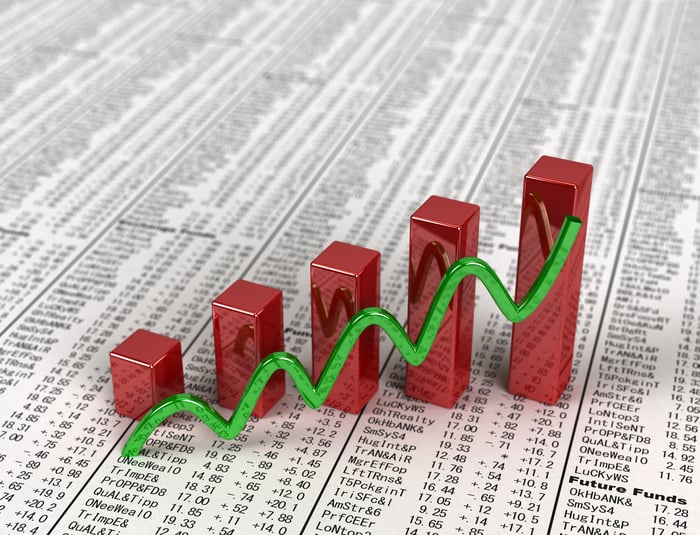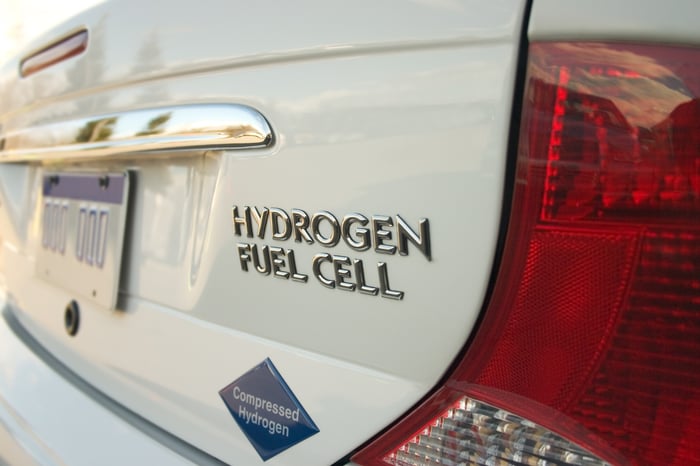Being an investor since the start of 2022 has been challenging. Last year, all three stock indexes plummeted into a bear market and produced their worst full-year returns since the Great Recession. Unless you were heavily invested in energy stocks, there were few places to hide.
However, big declines in the stock market are known for creating significant opportunities for investors. This is a fact not lost on Wall Street analysts or their financial firms. According to the loftiest price targets currently attached to three former highfliers, these unique stocks can skyrocket 314% to as much as 943%.

Image source: Getty Images.
Novavax: Implied upside of 314%
The first stock that has the potential to soar, at least according to one Wall Street analyst, is biotech stock Novavax (NVAX). Despite falling more than 97% from its all-time high during the COVID-19 pandemic, H.C. Wainwright analyst Vernon Bernardino sees shares of the company eventually hitting $35. If accurate, Bernardino's prognostication would result in a more than quadrupling of shares of Novavax.
Novavax gained its notoriety during the pandemic as one of the few drug developers to successfully produce a COVID-19 vaccine. Covovax (known as Nuvaxovid overseas) is one of only three COVID-19 vaccines to hit the elusive 90% vaccine efficacy mark in late-stage clinical trials.
Novavax appeared to be set up for immense success, but management dropped the ball. Multiple delays in Emergency Use Authorization filings, coupled with manufacturing ramp delays, caused Novavax to miss the bulk of the low-hanging fruit in developed countries (i.e., initial-series vaccines). With the worst of the pandemic now (hopefully) over, Novavax's COVID-19 gravy train has come and gone.
To make matters worse, it's not clear if Novavax has sufficient funding to make it through 2023. The issue ties to Novavax ending a contractual vaccine purchase agreement with Gavi in November. Gavi is seeking a refund of $700 million, but it'll ultimately be up to an arbitrator to make that ruling. For its part, Novavax closed out the March-ended quarter with $625 million in cash and cash equivalents, down from $1.34 billion just three months prior.
But it's not all bad news for Novavax. The company's 2023 sales forecast came in well ahead of Wall Street's expectations, and management outlined a plan to reduce the company's selling, general, and administrative expenses by an aggregate of 40% to 50% through 2024, compared to 2022.
Furthermore, Novavax is on track to deliver an updated COVID vaccine for fall, and the company reported positive results from its phase 2 COVID/influenza combination vaccine, as well as stand-alone influenza vaccine and high-dose COVID vaccines.
Novavax's vaccine-development platform is intriguing and works. The simple question is, does the company have enough cash on hand to enjoy an eventual ramp-up in sales?
Canopy Growth: Implied upside of 528%
A second unique stock Wall Street believes can skyrocket in the quarters and years to come is Canadian marijuana stock Canopy Growth (CGC 20.65%). Analyst Bill Kirk at MKM Partners set a price target on Canopy of 9 Canadian dollars ($6.59 U.S.) in mid-February. This would imply upside of 528% from where shares closed this past week.
Five years ago, Canadian pot stocks were white-hot. Canada's legalization of recreational marijuana in October 2018 lifted the proverbial door on a massive growth opportunity. Unfortunately, macro and company-specific miscues have turned Canopy Growth into nothing short of a buzzkill for its shareholders.
Some of the blame for Canopy's underperformance rests with federal and provincial regulators. For instance, Ontario, Canada's most-populous province, was slow to shift from a lottery system to a traditional vetting process when assigning dispensary licenses. Additionally, the U.S., which is a much more lucrative cannabis market, hasn't made any progress with regard to federal cannabis reforms.
Another problem for Canopy Growth is that Canadian consumers have predominantly gravitated to value-based pot products instead of the high-margin derivatives marijuana companies were counting on.
But make no mistake about it: Canopy Growth's poor performance was also self-inflicted. The company grossly overestimated its production needs. Despite netting multiple investments from spirits giant Constellation Brands that pushed its cash and cash equivalents above $4 billion at one point in late 2018, Canopy's fiscal third-quarter report (ended Dec. 31) featured less than $600 million in remaining cash and cash equivalents and an accumulated deficit since inception of $6.55 billion. Canopy has yet to push into the profit column, or frankly even come close.
For its part, Canopy Growth has announced plans to exit cannabis cultivation altogether, as well as lay off approximately 60% of its employees. While these cost-reduction initiatives are expected to get the company to positive adjusted earnings before interest, taxes, depreciation, and amortization (EBITDA) in 2024, it still doesn't mean Canopy Growth will be profitable anytime soon. In other words, Kirk's price target is highly unlikely to come to fruition.

Image source: Getty Images.
Plug Power: Implied upside of 943%
The third unique stock Wall Street expects to skyrocket in the years to come is hydrogen fuel-cell solutions company Plug Power (PLUG -0.73%). Analyst Amit Dayal of H.C. Wainwright has been steadfast in his belief that Plug will eventually reach $78. Dayal's target price being hit would mean 943% upside for Plug's shareholders.
The excitement surrounding Plug Power primarily has to do with the jaw-droppingly large addressable market green energy presents. Developed countries want to minimize their carbon footprints, which means an increased reliance on all forms of renewable energy, including green hydrogen solutions. Plug Power has guided for $5 billion in annual sales by 2026 and $20 billion come 2030. That's phenomenal sales growth for a company that reported only $701 million in full-year sales in 2022.
Established partnerships are another reason Dayal and his team are likely intrigued by Plug Power. In early 2021, Plug forged joint ventures (JVs) with South Korea's SK Group and French automaker Renault. The former JV will see Plug assist with fuel-cell development for vehicles and infrastructure throughout Asia. Meanwhile, the latter JV has Plug and Renault targeting Europe's light commercial vehicle market.
While its sales growth runway is massive, Plug's ability thus far to deliver on its bottom-line targets has missed the mark. Despite delivering 49% sales growth during the first quarter, the company's gross margin and operating loss both worsened on the heels of higher hydrogen costs.
Plug Power is also burning through its remaining cash and cash equivalents, which stood at nearly $475 million at the end of March. Plug's aggressive infrastructure expansions are eating up its capital at an alarming rate, which means potentially dilutive capital raises could be around the corner.
For what it's worth, Wall Street's consensus estimates call for Plug Power to turn the corner to profitability by 2025. But given the company's worsening cash flow as its revenue ramps up, Dayal's lofty price target is likely unreachable.





